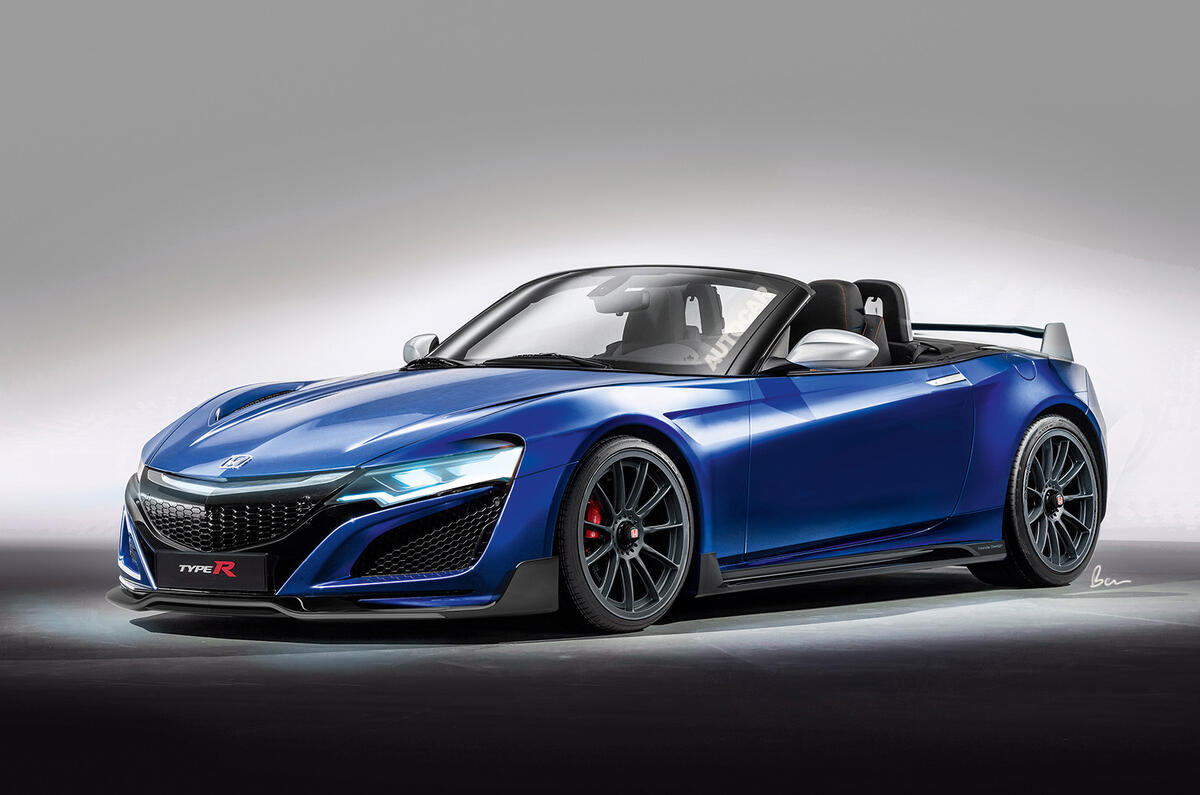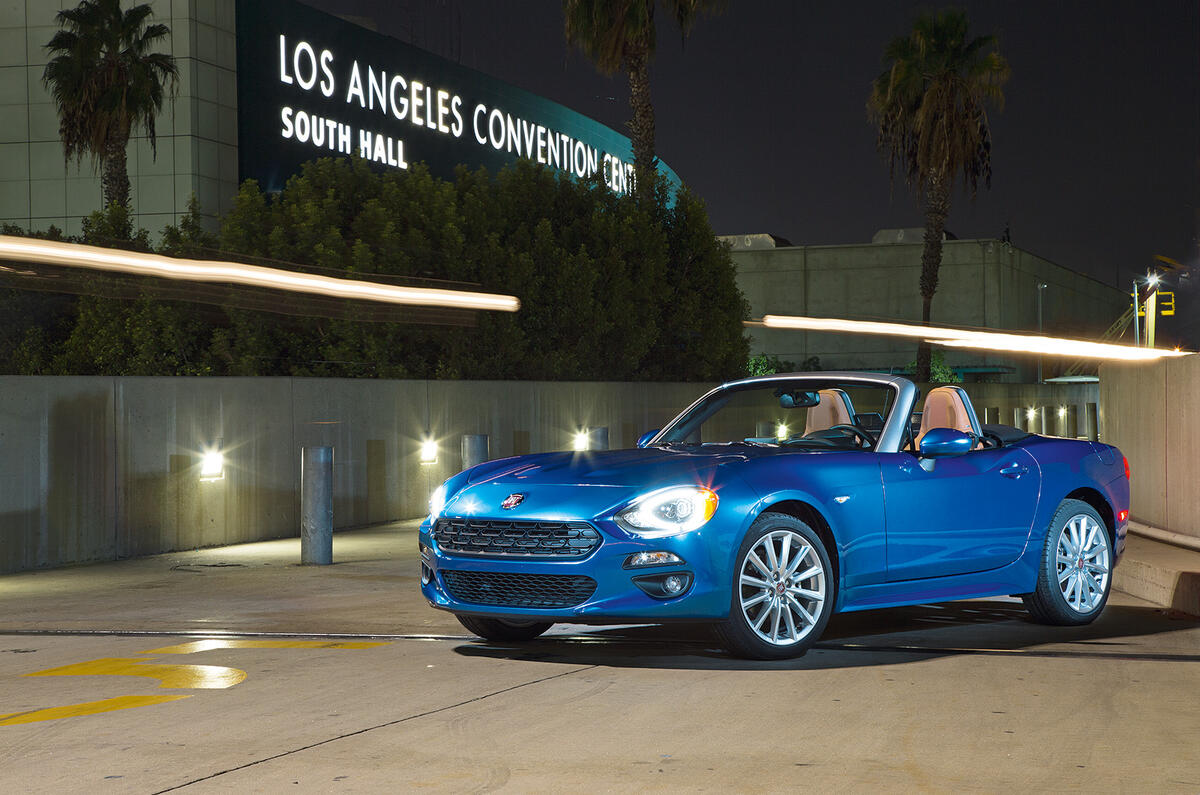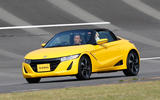Honda is taking aim at the Mazda MX-5 and Fiat’s forthcoming 124 Spider by developing a successor to its popular S2000 roadster, company insiders have revealed.
Introduced in 1999, the original version of the Japanese manufacturer’s two-seat roadster garnered a reputation for its strong powertrain and lively handling, but the second edition of the car was axed in 2009.
Now a third generation is said to be under development as Honda tries to reconnect with the S2000’s dedicated fan base. Representatives from Honda’s advanced engineering department are said to have attended a recent S2000 owners’ club event in the British Isles - a sign that the firm wants to listen to enthusiasts in order to help it to position the next version of the car accurately.
The new S2000 will stay true to the original’s principles of a front-mounted engine, sited behind the axle line, and rear-wheel drive. It will be pitched as a faster alternative to the MX-5, although its performance should be more of a match for that car’s stablemate, the forthcoming Fiat 124 Spider, which uses a 1.4-litre turbocharged engine instead of the Mazda’s naturally aspirated 1.5 and 2.0-litre units.
Honda has a number of powerplants under consideration for its roadster. More basic editions of the car could be powered by a retuned version of the firm’s forthcoming 1.5-litre turbocharged petrol engine. The four-cylinder unit has VTEC variable valve timing and produces around 150bhp in the Japanese-market vehicles it powers. This is likely to be ramped up to around 180bhp for the most modest S2000, giving the car around 25bhp more than the most powerful MX-5 and beating the US-market 124’s 158bhp.
This would leave scope for a hotter variant that could use a detuned version of the Civic Type R’s 306bhp 2.0-litre turbocharged engine. It would also feature more extreme suspension and chassis settings, including a rear limited-slip differential, and could give Honda a useful extension to its Type R sub-brand, as well as a rival for the more potent, Abarth-badged 124. All versions of the car would feature a short-throw six-speed manual gearbox.

The biggest obstacle in the way of the S2000 replacement is the absence of a suitable platform. Honda is committing to a new global architecture for front-wheel-drive cars, including the next generation of Civic, which is due on sale in the UK in 2017, but its opportunities to spread the costs of a rear-wheel drive chassis are more limited.
It is therefore likely to pitch the car as a more expensive rival to the MX-5 in a bid to maintain workable margins, with pricing starting north of £20,000. It could slot the model into the line-up of its premium Acura brand in the United States, where it would be a rival to BMW’s next Z4 and the Audi TT Roadster.
Honda has been working on a number of sports car projects as it looks to rebuild its reputation as a manufacturer of enthusiasts’ models as well as more mainstream products and capitalise on its struggling F1 programme with McLaren.
It is understood that a mid-engined, turbocharged ‘baby NSX’ is also under consideration, but company officials have prioritised a return to the open-top two-seater market.
Honda’s global boss, Takahiro Hachigo, recently revealed that despite the Honda NSX’s trick hybrid set-up, future sports cars from the company would not all need to have electric motors in their powertrains. “Whether or not we develop a hybrid depends on the type of car,” he said. “It is not the case that we have a fixed notion that a sports car always has to be a hybrid.”
Honda has decided that the diminutive S660 roadster that’s sold in Japan would not have a broad enough appeal to justify homologation in other markets. Hachigo said: “If there is strong demand from a region then we will always consider possibilities, but the S660 is a car that was developed for the Japanese market and we’d have to do a lot of work on it to make it comply with European regulations. I also wonder: would a car like this, sold in Asia, succeed in Europe?”
He did admit that Honda was considering sports cars beyond the NSX, however. “We are receiving requests from our regions who are saying they would like more sports cars, so we are considering ways to do that,” he added.
Engineers have also been working on a four-motor, all-electric sports car, as demonstrated by the SH-AWD CR-Z that finished 11th in this year’s Pikes Peak hillclimb in Colorado, but the commercialisation of that project faces a number of challenges, not least the cost of the lithium ion battery technology required to deliver the targeted range of 300 miles per full charge.Hachigo admitted that Honda had damaged its image by “abandoning” products such as the S2000 that had a strong reputation and hardcore fan base. The firm did have plans for a successor to the second generation of the car, but these were scrapped in the midst of the global automotive and financial crises in 2009.
It is believed that the firm’s European boss, Toshiaki Mikoshiba, has been given specific targets to improve continuity and nurture customer retention, as well as reducing the gap between product launches in Japan and the US and the arrival of those cars in Europe. The new HR-V and Jazz — plus the newly launched US-market Civic — are seen as prime examples of cars taking too long to reach European customers.
“We need consistency to build the brand,” said Hachigo. “We want to enhance the cars that we’ve already introduced. We are also working so we can introduce models more quickly to Europe. It’s a very important market for us.”
Honda is the latest Japanese brand to publicly state its goal to produce more cars that are fun to drive, although if the firm does get a new, rear-wheel-drive S2000 to market on its own, it will be bucking the recent trend for joint developments. Mazda and Fiat collaborated on the MX-5 and 124, while Toyota joined forces with Subaru to get access to the boxer engines that give the GT86 the handling agility that was the focus for the project.
Toyota is also working with BMW on a sports car platform that’s expected to underpin different sizes of car. BMW will place it under the next Z4 and its Japanese partner will use it to underpin a larger coupé that could carry the Supra badge.
However, some Japanese manufacturers are developing standalone sports car projects. Mazda is working on a rotary-engined successor to the RX-7 and RX-8 and Nissan is considering an expansion of its Z sub-brand.
Honda's S2000 is also seen as an investment car - read more in our used car buying guide.
The cars the new S2000 must beat
Fiat/Abarth 124 Spider - Sister car to the MX-5, the 124 Spider has more power and torque thanks to Fiat’s 1.4 turbo Multiair engine. UK-spec 124s will have a 138bhp engine at launch, but sources are speaking about an Abarth version with at least 168bhp, a more focused chassis and the option of a fixed roof.
BMW Z4 - BMW had been considering a baby front-drive roadster, but that project is on hold, so the next Z4 will remain the firm’s smallest drop-top for now. It’ll be spun off a platform developed with Toyota, although the Japanese brand is expected to use the architecture to build a larger model.
Nissan Z-Car - While Nissan’s Gripz concept shows how it plans to extend the Z line-up to include crossovers, that car is seen as an extension to the sub-brand, not a replacement for the rear-drive sports car. Expect the next Z to use a turbo four-cylinder engine and cost less than the outgoing 370Z.
Mazda MX-5 - No-frills roadster has received widespread acclaim in its latest generation, which makes do with modest 1.5 and 2.0-litre naturally aspirated engines but sheds weight to ensure decent performance and fantastic handling agility. Its pricing could make the Honda look expensive, too.
Alpine A120 - Reborn French brand’s two-seater is due next year. It will use a 250bhp 1.8-litre turbo engine, but a 300bhp version is also planned. Hardcore dynamics will appeal to the enthusiasts Honda hopes to snare with the S2000, but the A120 will cost more, with prices starting at about £30,000.
Comment - would the S660 work in Europe?
Honda does have a drop-top sports car in its line-up, but only in Japan - and it should really stay there. The S660 is a kei car, designed to beat Japanese vehicle tax rules, and as such it is (a) tiny and (b) modestly powered by a 660cc engine.
We had a chance to try the car on the eve of this year’s Tokyo motor show, and while it has some fine characteristics, including a particularly sweet short-throw gearshift, it would also be outgunned pretty much anywhere outside of town.
Even if you did have the patience to get it up to motorway speeds, the extreme wind buffeting would probably persuade you to back off.
The cabin is minuscule, too, and anyone more than 6ft tall would struggle to find a comfortable seating position. Honda’s bosses say the costs of homologating the car for sales outside Japan couldn’t be justified by the potential sales, and for all the S660’s charm, we’re inclined to agree. If the firm wants a genuine rival for roadsters such as the MX-5 and 124 Spider -the car that it freely admits its regions are asking for - it’ll need to try harder.
Read more:























Join the debate
Add your comment
Yeah, the Honda Civic 1.8...
Honda 20% sales fall in 2014 due to...
News: Honda are putting Smaller Turbo engine in next Civic
xxxx wrote: Just found out,
So only 5 years behind Ford then. If you include stuff like VW's 1.4 Tsi, then 8 years.
xxxx wrote: Just found out,
'More efficient', now we are getting back to my original point. The 1.8 is not, as you claim, an inefficient engine, but there are other slightly more efficient petrol engines available. To rely on the EU figures would be naive, it has been shown time and time again they do not represent real world performance, and given we all drive in the real world and not in a lab, I know which I'm more inclined to believe. As I see it, downsized turbo petrols are not delivering their claimed efficiency improvements, and certainly not enough progress to warrant all the technology they rely on. However, given Honda's history of producing impressive engines, their new engines may just be worth the wait.
Will86 wrote: xxxx wrote:
Sorry but Honda are almost last in bringing out mass market downsized turbo petrol engines and their sales have suffered big time, in the UK at least. You think the current 1.8 is efficient despite the high CO figure and bad reviews (see above) so we're just have to disagree. IMO